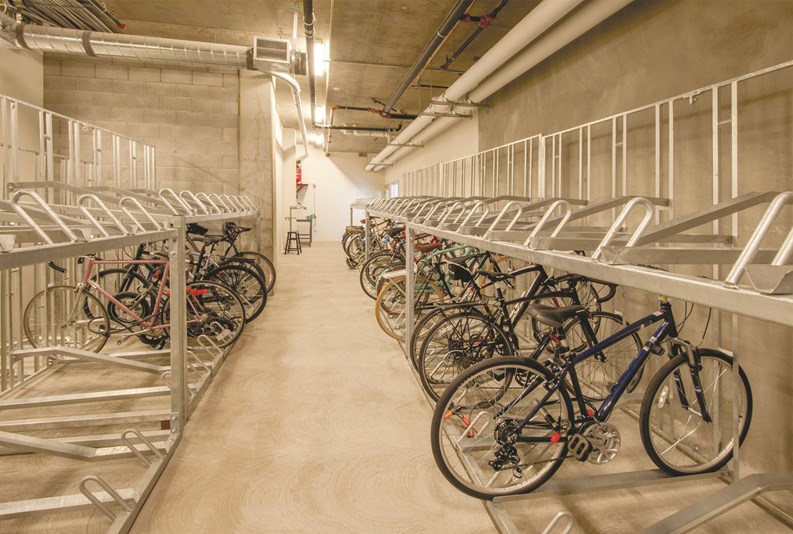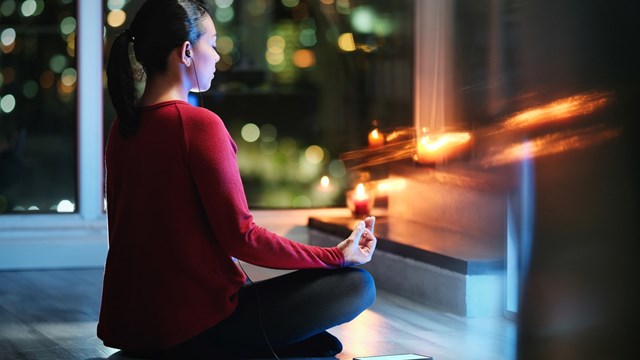For the last decade or so, newly-constructed residential buildings have featured all kinds of new amenities, from the opulent to the simple, and the trend shows no signs of slowing down. This leaves older buildings sparser amenities in a lurch, making it harder for them to draw in new residents and justify asking prices. Not wanting to be swept away by the tides of progress, older buildings have been doing their best to keep up.
The Bike Race
“There’s an amenities arms race between new construction and older buildings,” says Richard Cohen, the president of Velodome Shelters, a company in the tri-state area that designs and creates bicycle storage rooms and stations. “It used to be just a washer and dryer, then it was the fitness rooms, and now most buildings have bicycle rooms. In older buildings they have empty space that’s used as bicycle rooms, but they waste so much space and it looks like a jungle.”
In 2009 the New York City Department of Buildings (DOB) passed a zoning amendment that required newly constructed buildings - as well as substantially enlarged buildings and those converted for residential use - with 10 apartment units or more to provide one bicycle space for every two units. As a result, bicycle storage has become more and more common, leaving older buildings rushing to catch up.
“On new construction the DOB mandate is one bike parking space for every two units of new construction,” says Steven Frind, co-founder of Rack and GO in White Plains. “It gets a little bit trickier with existing buildings, since there is no mandate. We typically recommend the same sort of formula as a guideline. Some buildings don’t need as many spaces, while some need more.”
“It’s a constant flow of interest,” says Ben Cramer, a salesman with Dero, a national bike storage company. “In New York, the priorities are maximizing bicycle parking for the space, and security. Very typically I will see a small- to medium-sized room on the ground floor or basement, where we now see piles of bicycles in utter disarray. Management will be looking to find a systematic way of parking those bicycles in a much more user-friendly and secure way.”
According to Cohen, the first step in establishing a neater, more formal bike storage area in your building or association is to gauge residents’ interest. “What often happens is a building will send out a survey or sign-up sheet at the front desk [to see] how many people are interested in storing their bicycles and willing to pay the fee. From there, you’ll know how much space you’re going to need.”
According to Jerry Desir of Queens-based Giant Industrial Installations, Inc., which is the local representative and New York office for WireCrafters brand storage units, “Most buildings usually try to offer one space per apartment. It’s best for existing buildings to try and count how many bikes they have so they know exactly storage spaces they need. You can walk into a building that has 200 units, but only 25 bikes. In a case like that you want to install storage for 30 bikes - because ‘If you build it, they will come.”
Cramer concurs, noting that just because you get a dozen people expressing interest in bike storage doesn’t mean you’ll only need to make space for 12 bikes. “Typically a biking family will have 2-4 bicycles, so I think about 2 bicycles per apartment is a good measure, especially if you’re near a park or bikeways. Very consistently, buildings expect to park a certain number of bicycles, only to see demand for spaces go up once it becomes available. To park 30 bicycles, say you’ve got a room 16ft by 10ft, you’d be able to fit them in there just fine.”
Smart Use of Space
“Not all bicycle rooms are perfect rectangles; sometimes there are columns or storage lockers in the way,” says Cohen. “So it helps if someone on the board can take some general dimensions, then someone from the [storage] company can come down, look at the space, take measurements and do a free layout and CAD drawing, so we can get as many bicycles as possible in while still being functional.”
And Desir notes that sometimes a bike storage room isn’t a room at all; “The requests are mostly for indoor storage, but I’ve found that existing buildings might not have enough room, so we get calls asking for an outdoor shed so they can store their bikes there. We’re actually starting to get a lot of calls about outdoor storage, but 90% of people are still asking for indoors.” Cramer agrees, adding that “Outdoor space tends to be so limited, not that indoor space isn’t limited. That said if you have a narrow alleyway or courtyard that’s a good place to park bicycles as well.”
When it comes to optimizing space, “It’ll start with how much space is available, and then determine what kind of bike racks to use,” says Cohen. “There are a variety of styles, and it’s a good idea to mix them up, since not everyone can use every kind of storage device. The most common ones in storage rooms are vertical storage. They leave more aisle space than other racks.”
According to Frind, “There are typically two types of high-capacity of indoor storage. One is a vertical system, where the bikes are hung up on a rack stand. For that you need about 10 square-feet of free space. The other option is to do a two-tier system. For that you need about 15 square-feet, but because we’re parking bikes one over the other, the average is 7.5 square feet.”
As Cramer explains, a double-decker solution is just as it sounds: one bicycle at floor level and another suspended above, usually on a thin platform that slides down and allows the user to just roll their bicycle onto it before sliding it back up. By mixing and matching, a single building will be able to optimize their space and fit a large number of bicycles in a single room.
Cost and Usage
The cost of storing an individual bicycle isn’t too extravagant, though for larger buildings with a lot of cycling residents looking for storage, it can get a little pricey.
“Customers can expect to pay from $50-$250 per bicycle in terms of bicycle parking equipment,” says Cramer. “That’s just for the [hardware]; from there, the building can either install it themselves or contract that out.”
Of course that doesn’t mean the board will be out that money with no way to make it back. As Cramer notes, charging a small fee for storage has a few benefits, not least of which is helping to pay for the cost of the storage room.
“Charging even a small fee is a good idea,” he says. “Buildings can pretty quickly pay back what they’ve invested in the space, even if only charging $2 or $10 a month. It’s also a way of avoiding derelict bicycles.” While some buildings charge as little as $5 per month for bike storage and others as much as $50, Cohen says “The average tends to be between $12 and $15 per month. We always recommend the building charge something, even if it’s a little bit - otherwise people may have moved out, died or whatever and their bicycles could be down there for years.”
Whatever the amount, bike storage fees are typically just added on to a residents’ monthly maintenance bill. In addition to being easy to keep track of, the automatic billing enables the board or management to know when a space opens up if a resident moves, or for some reason decides they no longer want or need to store their bike. If there’s a waiting list for space, the next person in line can take over the storage spot.
As New York City and other metropolitan areas embrace bikes as a viable, healthy, and environmentally-friendly mode of travel, count on more and more buildings offering bike storage not just as a luxury, but as a necessary amenity for their residents, both new and old. With a little research and forethought, your building or association can get on the bike-wagon too.
John Zurz is a staff writer and reporter with The Cooperator.







Comments
Leave a Comment